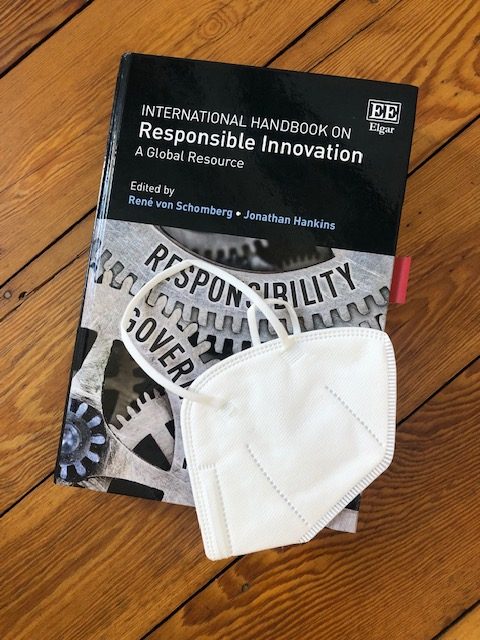[…] the ongoing but gradually changing discussions concerning both the virus and the measures to prevent its spread gives me the benefit of hindsight when stress-testing the concepts and practices of responsible research and innovation described in the handbook against how they actually fared in the case of a pandemic.
Dr Steffi Friedrichs, AcumenIST, Book Review: International Handbook on Responsible Innovation — a Global Resource, published: 30th August 2021

AcumenIST Dr Steffi Friedrichs uses her review of the International Handbook on Responsible Innovation — a Global Resource, edited by René von Schomberg and Jonathan Hankins (ISBN: 9781784718855) to see, how concepts and practices of Responsible Research and Innovation (RRI) have been (and continue to be) applied during the coronavirus pandemic, and where they have been successful, or reached their limits.’The International Handbook on Responsible Innovation — a Global Resource describes many such concepts and practices of Responsible (Research and) Innovation that were applied during the pandemic, enabling all of us to gauge the observable widespread progress in developing and adopting R(R)I as an important pillar of the foundations of science, technology and innovation worldwide. And while observations generally seem to indicate that the pandemic did indeed spur some research and innovation activities of unprecedented speed and successful results thereof (not least in the form of vaccines), we should turn to the handbook for guidance on how to embark now on a new area of increased importance of research and innovation,’ Dr Friedrichs notes, before providing a details review of the handbook:
‘The handbook is structured in five main parts:
- Part I outlines the different concepts underpinning R(R)I that stem from (a) responsibility and ethics, (b) governance and (c) responsible innovation in organisations: Concepts underpinning responsible innovation.
- Part II describes R(R)I’s role beyond scientific and technological disciplines, and its responsibility in addressing the right impacts in local, regional and specific cultural contexts: Responsible innovation — becoming responsive to the global societal challenges.
- Part III demonstrates a number of advanced R(R)I practices in the context of the specific technologies they had been designed for and applied to: Embedding responsible innovation in emerging technological practices.
- Part IV counterposes the technology-specific examples of the previous part with R(R)I practices that are regionally and culturally sensitive: Regional practices.
- Part V provides the transcript of three in-depth interviews with prominent representatives from within the practitioner community of R(R)I: Interviews.’
Nanotechnology — a Field Day for STS-Scholars
Dr Friedrichs follows the handbook’s editors back to the early 2000s, when scholars of ‘science and technology studies (STS-scholars) were ‘increasingly focusing on the then new field of nanotechnology, thus highlighting ‘the handbook’s nature as a true source of reference that enables the reader to transfer the R(R)I practices in the described regional, societal, cultural and technological settings to other contexts’; in the context of today’s pandemic, one could therefore ask the following questions: ‘Without the introduction of R(R)I, …
- … would we have been able to benefit from the same rapid scientific assessment of the virus, its characteristics, epidemiology and its pathobiological effects, as well as from the immediate open sharing of its results around the world?’
- … would we now be benefitting from the rapid development, authorisation and manufacture of numerous vaccines all over the world, marking an unprecedented hand-in-hand collaboration between universities, industries and governments?”
What is ‘Responsible’? — and if so, How Many?
‘Richard Jones recalls a corresponding observation of the numerous and diverse public engagement processes pertaining to the subject of nanotechnology: ‘We have learnt that public engagement can deliver some clear messages about the directions that wider society would like technology to evolve towards; what is less clear is the degree to which the recipients of those messages have any agency to act on them’ (Chapter 23). He takes the reader back to the early 2000s in order to draw specific lessons from the case of nanotechnology; at the time, when it was experiencing both unrealistic hype and somewhat science fiction-driven opposition, first commercial examples of the technology that had been coined as a phenomena-based discipline in its own right were entering the market. While some organisations called for a moratorium on all nanotechnology commercialisation and research, other groups strongly supported the application of nanotechnologies in medicine and healthcare, under ‘explicit rejection of an unduly precautionary approach.’ Jones highlights a fundamental problem of the manifold public engagement exercises of the time: ‘In many cases, there is a mismatch between the messages that have been coming from the public and the capacity of the people or organisations to deliver any of the changes that the public desire.’’
How to Conduct R(R)I When There is No Pandemic?
‘While there is little to question about the idea of giving priority to the grand challenges of our timeFootnote14 and accepting that the COVID-19 outbreak has created an unprecedented example of the latter, thereby serving as a magnifying glass to scrutinise all those aspects of R(R)I that enabled the roll-out of rapid responses to an acute grand challenge in the form of a pandemic, it also becomes very clear that none of these rapid reactions would have been possible without the constant prior support of knowledge generation and infrastructures for science, technology and innovation, or without the ongoing collaboration between universities, industries and governments. And while innovations in pandemic-free times may not be regarded as being as universally useful as life-saving vaccines and treatments, they always contribute to the generation of knowledge, understanding and education, and their commercialisation enables the creation of skilled jobs and state-of-the-art infrastructures.’
What Do You Want to be When You Grow Up?
All signs appear to indicate that R(R)I is well on its way to becoming a proud pillar of the advancement of science, technology and innovation worldwide, and that it will be able to address all of the abovementioned on-frame challenges by casting an increasingly wide assessment net.
The International Handbook on Responsible Innovation — a Global Resource is a formidable witness to this ‘coming of age of responsible innovation (RI)’, as Christopher Coenen puts it in his cover testimonial. However, re-reading this handbook, which harbours such a wealth of knowledge and practical advice for R(R)I practitioners, during the COVID-19 pandemic also shows that all concepts of responsibility and reflexivity are only as good as the objects of its ‘re’-active ideas allow it to be.
In that sense, Dr Friedrichs calls for a second and third volume of this excellent handbook, in order to directly address stakeholders and policy-makers respectively, and alert them to their own roles and responsibilities in the adoption and advancement of R(R)I.








